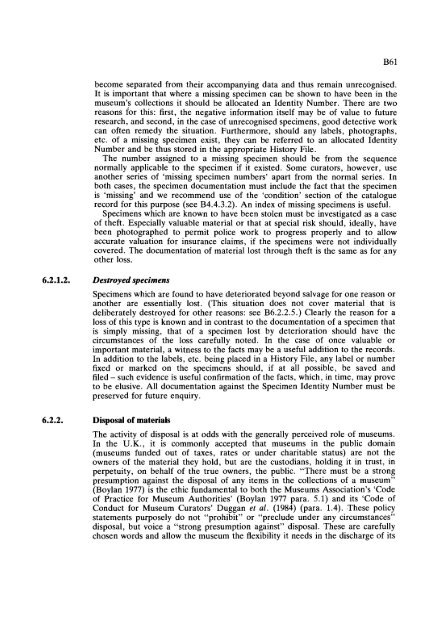GUIDELINES FOR THE CURATION OF GEOLOGICAL MATERIALS
GUIDELINES FOR THE CURATION OF GEOLOGICAL MATERIALS
GUIDELINES FOR THE CURATION OF GEOLOGICAL MATERIALS
You also want an ePaper? Increase the reach of your titles
YUMPU automatically turns print PDFs into web optimized ePapers that Google loves.
ecome separated from their accompanying data and thus remain unrecognised.<br />
It is important that where a missing specimen can be shown to have been in the<br />
museum's collections it should be allocated an Identity Number. There are two<br />
reasons for this: first, the negative information itself may be of value to future<br />
research, and second, in the case of unrecognised specimens, good detective work<br />
can often remedy the situation. Furthermore, should any labels, photographs,<br />
etc. of a missing specimen exist, they can be referred to an allocated Identity<br />
Number and be thus stored in the appropriate History File.<br />
The number assigned to a missing specimen should be from the sequence<br />
normally applicable to the specimen if it existed. Some curators, however, use<br />
another series of 'missing specimen numbers' apart from the normal series. In<br />
both cases, the specimen documentation must include the fact that the specimen<br />
is 'missing' and we recommend use of the 'condition7 section of the catalogue<br />
record for this purpose (see B4.4.3.2). An index of missing specimens is useful.<br />
Specimens which are known to have been stolen must be investigated as a case<br />
of theft. Especially valuable material or that at special risk should, ideally, have<br />
been photographed to permit police work to progress properly and to allow<br />
accurate valuation for insurance claims, if the specimens were not individually<br />
covered. The documentation of material lost through theft is the same as for any<br />
other loss.<br />
6.2.1.2. Destroyed specimens<br />
Specimens which are found to have deteriorated beyond salvage for one reason or<br />
another are essentially lost. (This situation does not cover material that is<br />
deliberately destroyed for other reasons: see B6.2.2.5.) Clearly the reason for a<br />
loss of this type is known and in contrast to the documentation of a specimen that<br />
is simply missing, that of a specimen lost by deterioration should have the<br />
circumstances of the loss carefully noted. In the case of once valuable or<br />
important material, a witness to the facts may be a useful addition to the records.<br />
In addition to the labels, etc. being placed in a History File, any label or number<br />
fixed or marked on the specimens should, if at all possible, be saved and<br />
filed - such evidence is useful confirmation of the facts, which, in time, may prove<br />
to be elusive. All documentation against the Specimen Identity Number must be<br />
preserved for future enquiry.<br />
6.2.2. Disposal of materials<br />
The activity of disposal is at odds with the generally perceived role of museums.<br />
In the U.K., it is commonly accepted that museums in the public domain<br />
(museums funded out of taxes, rates or under charitable status) are not the<br />
owners of the material they hold, but are the custodians, holding it in trust, in<br />
perpetuity, on behalf of the true owners, the public. "There must be a strong<br />
presumption against the disposal of any items in the collections of a museum"<br />
(Boylan 1977) is the ethic fundamental to both the Museums Association's 'Code<br />
of Practice for Museum Authorities' (Boylan 1977 para. 5.1) and its 'Code of<br />
Conduct for Museum Curators' Duggan et al. (1984) (para. 1.4). .These policy<br />
statements purposely do not "prohibit" or "preclude under any circumstances"<br />
disposal, but voice a "strong presumption against" disposal. These are carefully<br />
chosen words and allow the museum the flexibility it needs in the discharge of its

















